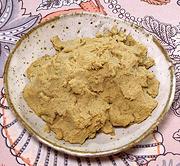|
ar
|
|
Tua Nao Paste
|
- You will need two sheets of plastic, about 6 inches square and
about the thickness of a large Ziploc bag. You will also need a
drying rack with a fairly small grid. I use the trays from my
dehydrator.
- Set one sheet of plastic on a flat surface. I find it difficult
to get disks off the bottom sheet, so I wipe it with a paper towel
lightly wetted with Olive Oil before making each disk - there should
be no visible oil. If you have trouble with the top sheet, do the
same there.
- Make a ball of the Tua Nao Paste about the size of an English
Walnut. Set it on the bottom plastic sheet.
- Place the top plastic sheet over the ball and squeeze it down
carefully to make a disk about 3-1/4 inches in diameter, or however
works with your paste.
- Carefully peel off the top plastic sheet.
- Carry the disk to the drying rack on the bottom sheet, then
quickly invert it onto the rack. Carefully peel off the sheet of
plastic.
- Repeat until you have as many disks as you want, or run out of
Paste or drying rack space.
- Normally, these racks are set out to sun dry the disks. This will
take a couple of days (take them in at night). Using my dehydrator,
I set it at fan on and low heat, leaving it run for a day and a
night. The disks need to be very dry and brittle. Don't worry if
they crack, you'll be pulverizing them for use anyway.
- To use the disks, just run pieces to powder in your spice grinder.
Most recipes will ask you to toast the disk over flame or on a
dry pan before grinding. I dry pan toast until just slightly darker.
Each will have the power of the number of Tablespoons of paste used
to make it.
|



